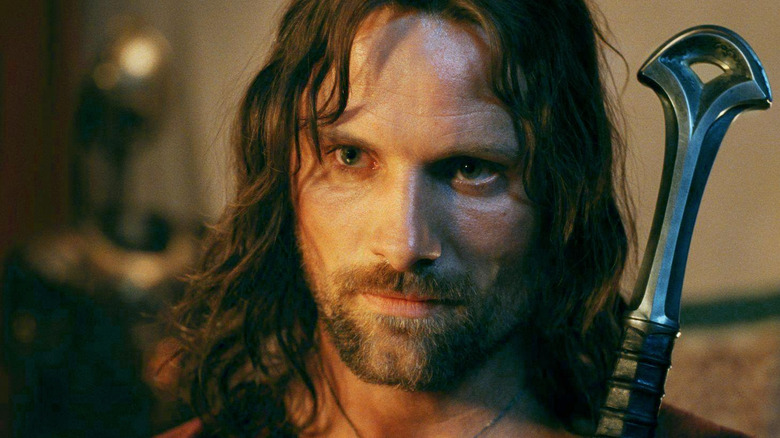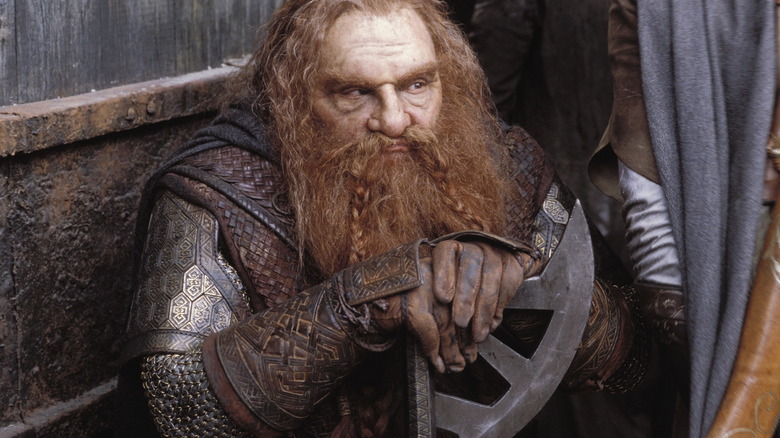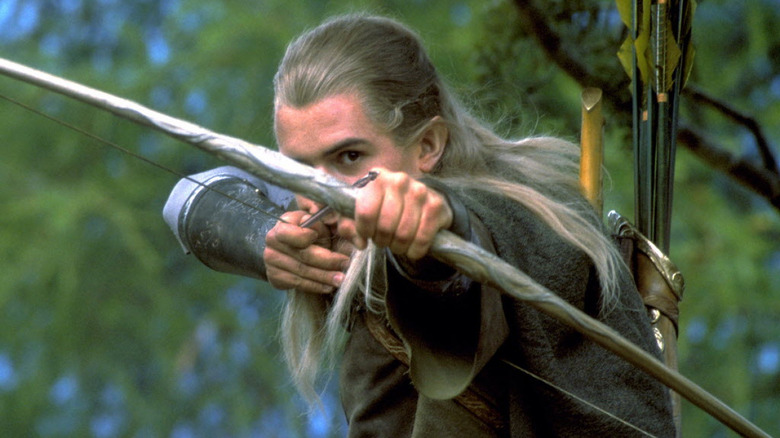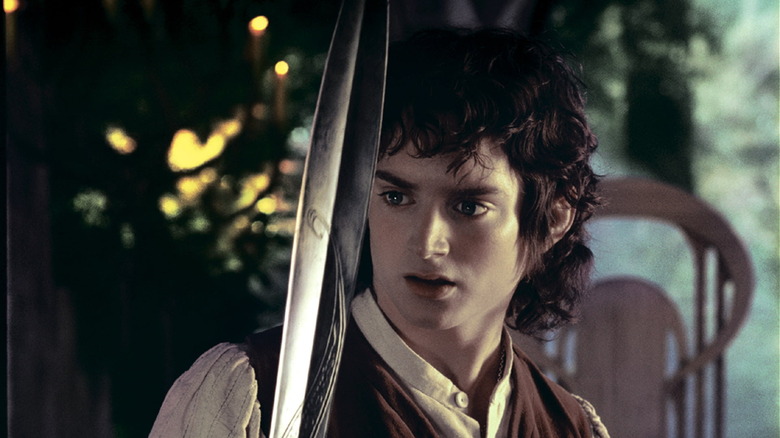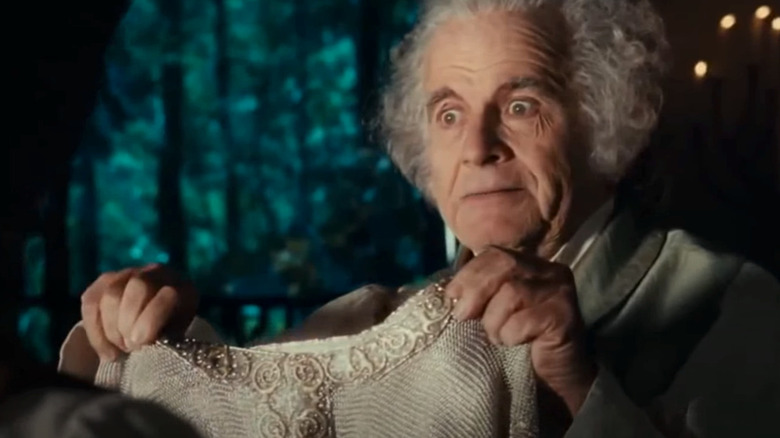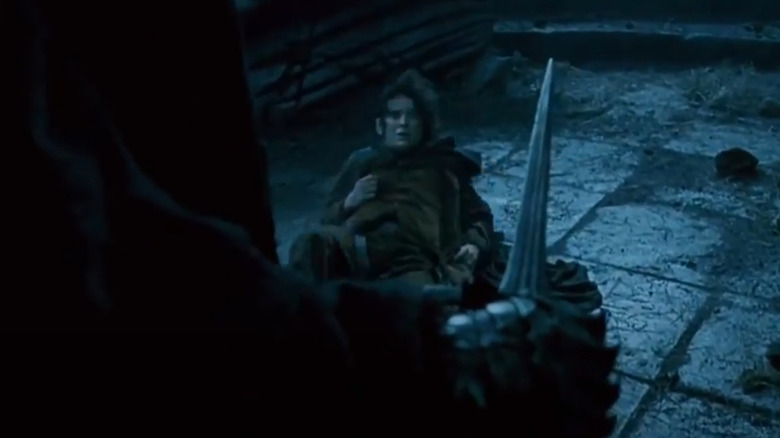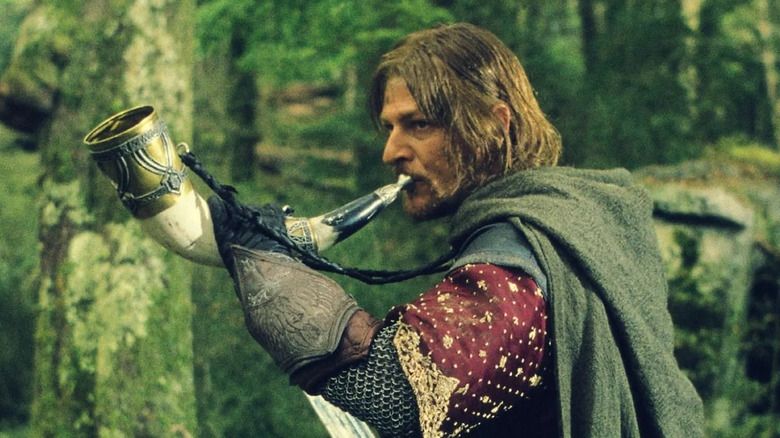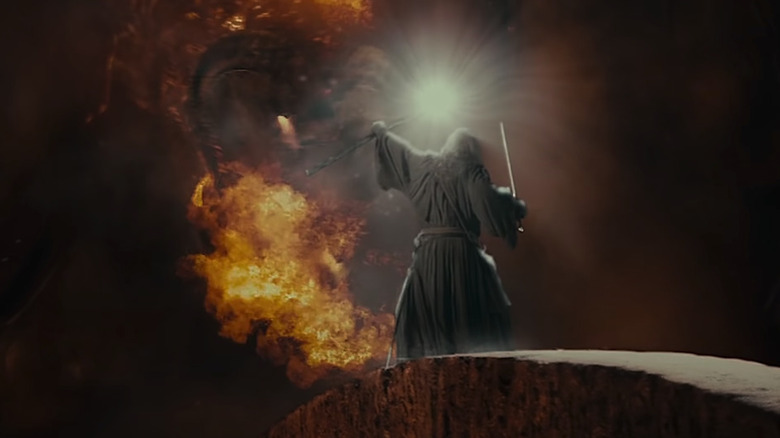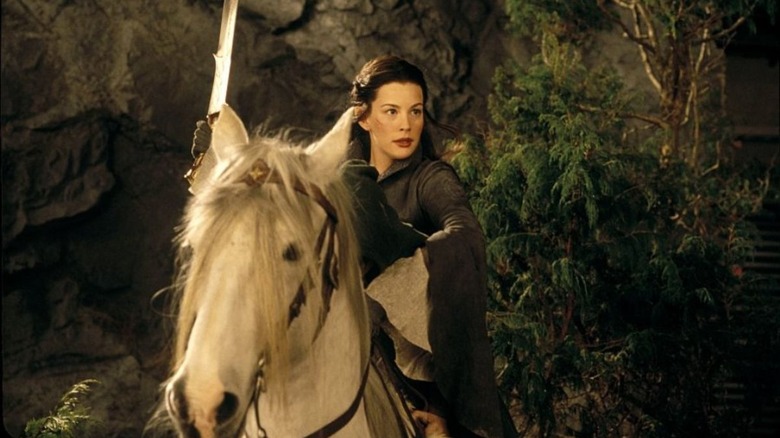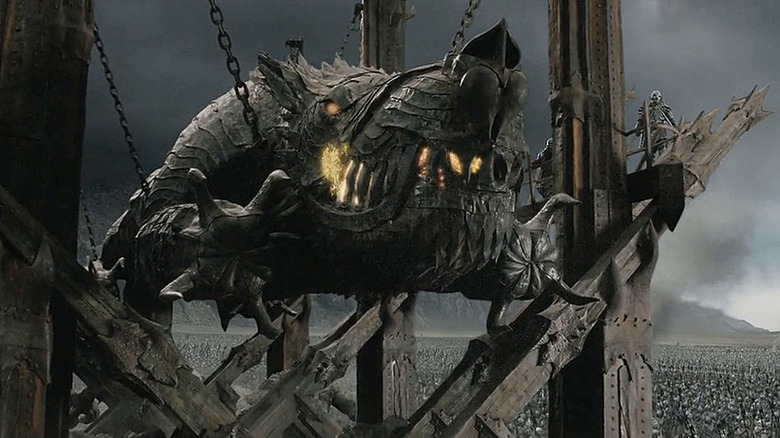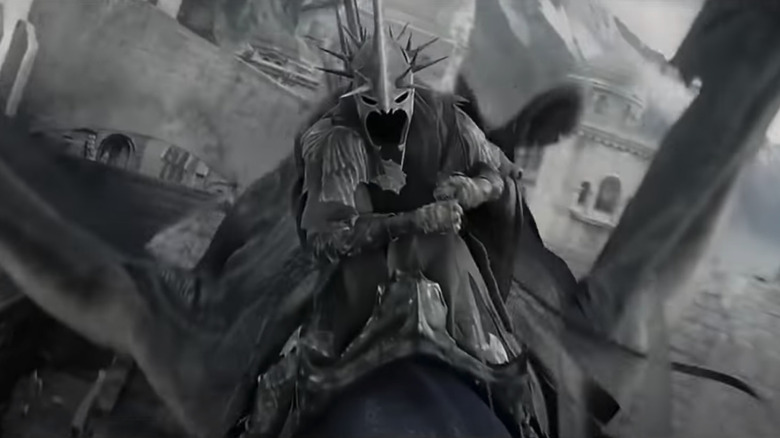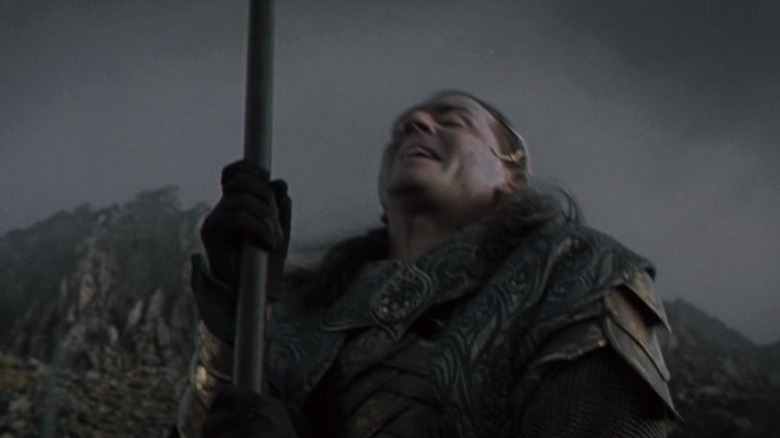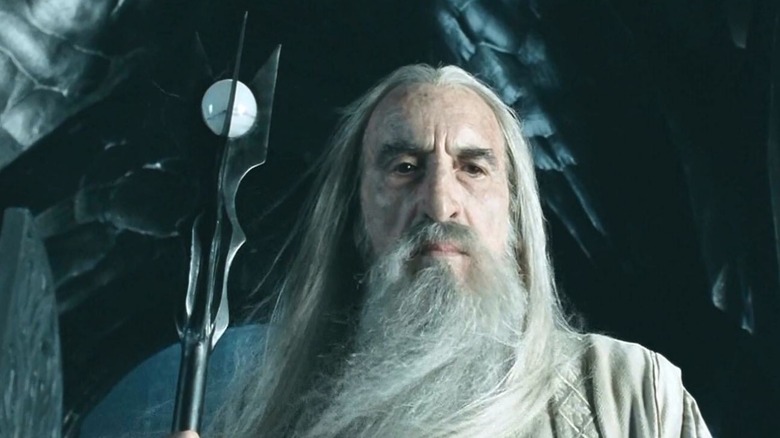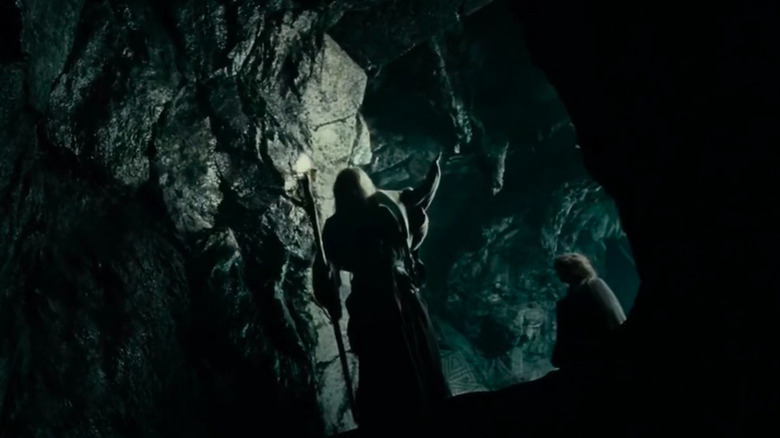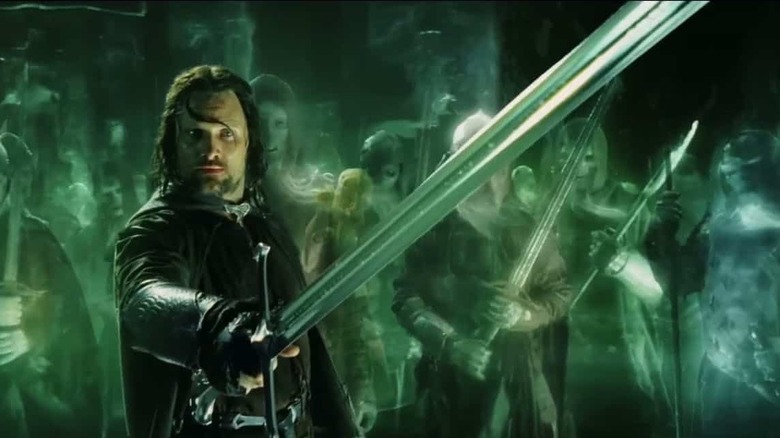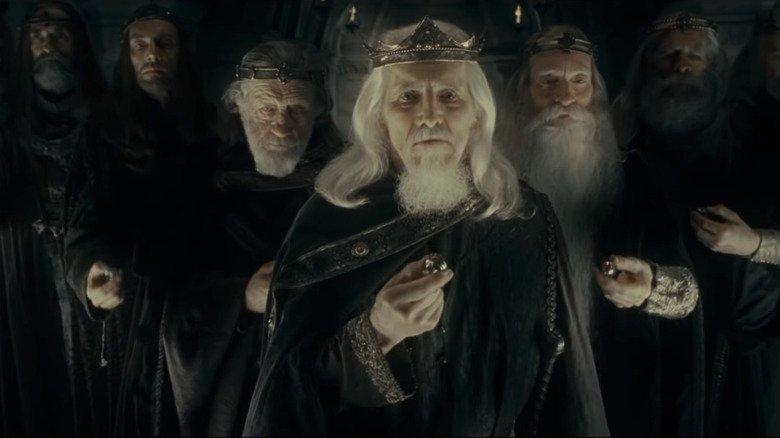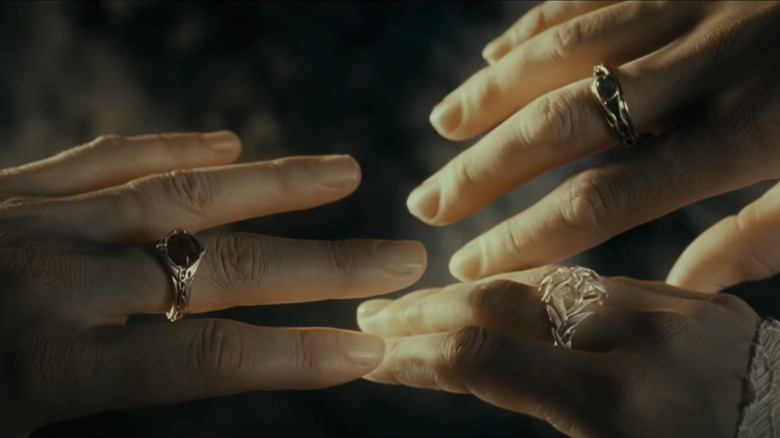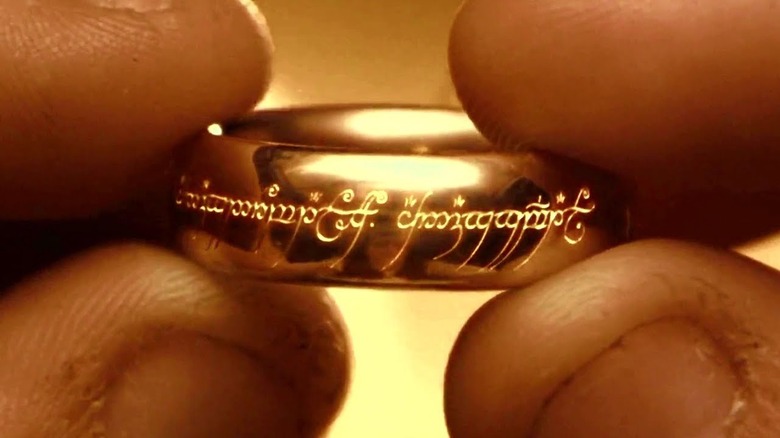The Most Powerful Weapons In The Lord Of The Rings Franchise Ranked
J.R.R. Tolkien tended to obsess over certain things in his world. He loved eucatastrophes (those epic, last-minute heroics like the Eagles arriving to save the day). He was always working some kind of precious jewel or trinket into his writings, too, from Silmarils to the Arkenstone, Aragorn's Ring of Barahir, and, of course, the Rings of Power.
And then there are the weapons. From the earliest days of his mythology, Tolkien sprinkled epic weapons throughout the history of his fantastical world. The Dark Lord Morgoth wielded an ancient Hammer called Grond (more on that in a bit). Aragorn's ancestor, Beren, wielded the knife Angrist when he cut a jeweled Silmaril from Morgoth's crown. Even the upcoming "Rings of Power" — which is set in the later Second Age of Middle-earth history — is already busy showcasing broken swords in its promotional footage.
And then there's the "The Lord of the Rings." Even by the end of the Third Age, when that story takes place, weapons are still extremely important items. Daggers, bows, axes, armor, horns, hammer, swords, and staffs all have a place in the proceedings (and many have names, to boot).
We've gone through and gathered up the most important of these and ranked them in order from the least powerful to the most powerful. In this ranking, we've considered two things: the inherent power of the weapon itself, and the potential it has in the hands of whoever wields it. Alright, ready to rank some overpowered Middle-earth armaments? Let's do this thing.
17. Gimli's axe is good but not great
Everyone knows about Gimli's axe. The broad-bladed possession is literally the item that he offers when volunteering to join the Fellowship of the Ring. And the Dwarven warrior definitely uses his weapon with great effect. At Helm's Deep, he kills more Uruk-hai with his Axe than Legolas manages to take out with his bow and knives combined.
And yet, at the end of the day, Gimli's axe is just that, an axe. Sure, it's probably really well made since he's a royal member of the Lonely Mountain, where everything metal is made with the highest level of smithcraft. But still, it's just an axe. As far as we know, it doesn't even have a name.
The fact that the axe belongs to Gimli and that he uses it magnificently is a pretty good argument, but it just can't top the rest of the weapons on this list. Not even Legolas' bow. And before you start throwing things at your screen out of protest that Gimli's weapon goes even lower than Legolas' battlefield tool of choice, we have one counterpoint to your protesting projectiles: the Nazgûl. What do they have to do with Legolas' bow? We're glad you asked.
16. Legolas' bow is pretty sweet
If you really want to get technical about it, Legolas' first bow (the original one he has from Mirkwood) should be at the bottom of this list. But that's not the bow we're talking about here. When he visits Lothlorien in "The Fellowship of the Ring," his smaller woodland bow is swapped out for one of those used by the Galadrim (that is, the people of Lothlorien). In the book, it says that it is "longer and stouter than the bows of Mirkwood, and strung with a string of elf-hair."
This is the bow that Legolas uses to mow down Uruk-hai at Helm's Deep and again at the Battle of the Pelennor Fields. But he also uses it, not long after he gets it, in a particularly important way. When the Fellowship travels in boats down the Great River, there's a point in the books where they run into the flying Nazgûl for the first time. It happens at night, but that doesn't stop Legolas from pulling out his bow ... and shooting the darn thing right out of the sky.
Does Gimli's axe get more done in a face-to-face battle with swarms of Orcish enemies? Sure. But it's never killed one of the Black Rider's hell-hawks. Game. Set. Match.
Of course, there are many other weapons besides those of these two friends, and it turns out that they only get more powerful from here.
15. Sting gets the job done
Next up, we have a Middle-earth stape: Sting. This is one of the few dagger-size weapons in Tolkien's writings that gets its own name ... and completely lives up to the hype. Of course, Sting's official adventures start in "The Hobbit," when Bilbo beats off an army of spiders in Mirkwood and names his blade after its stinging impact on his enemies.
In most cases, that would be enough to warrant an honorable mention, at least, but for this little blade, it's just the tip of the iceberg. Sting also helps Bilbo fend off Gollum earlier in the story — an element that is crucial to the "LOTR" narrative that follows. And that's all before it's bequeathed to Frodo at Rivendell in "The Lord of the Rings."
After that, Sting goes on one of the most harrowing journeys of all time. Its blade, which flickers blue when Orcs are near, warns Frodo of nearby enemies more than once. It's also a key factor in permitting Frodo and Sam to escape Shelob's webs ... and then deals the definitive stab on the monster herself. In "The Two Towers," we find out how unique this wound is when it says, "No such anguish had Shelob ever known, or dreamed of knowing, in all her long world of wickedness. Not the doughtiest soldier of old Gondor, nor the most savage Orc entrapped, had ever thus endured her, or set blade to her beloved flesh." That's right. Sting is the only weapon to ever pierce Shelob. High praise for a little blue dagger.
14. Frodo's mithril armor is remarkably effective
Okay, okay. We hear you. Armor isn't necessarily always seen as a "weapon." But the official Merriam-Webster definition reads as something used to defeat, destroy, or injure another. It also adds the secondary definition "a means of contending against another." Sounds like armor to us. And if you're going to pick a piece of armor that is ultra-powerful in "The Lord of the Rings" story, you don't have to look further than Frodo's torso.
The mail coat that Bilbo gets from Thorin and later gives to Frodo is made of Moria silver, also known as Mithril. It stops an Orc arrow dead in its tracks when the Fellowship is ambushed during their boat travels. It resists the incredible force of an Orc Chieftain's spear in Moria — an event that is so violent that it causes Aragorn to comment that it would have skewered a wild boar.
And then there's its monetary value. Gandalf declares that the little coat of chained links is worth more than the value of the Shire and everything in it. Hyperbole or not, the Mithril corslet is clearly a very expensive piece of battlefield attire that can generate enough wealth to have power all its own. Add in the fact that the Mithril armor is extremely light and easy to wear, and it becomes one of the most quietly powerful defensive weapons in all of "The Lord of the Rings."
13. The Nazgûl's Morgul-knife is spiritually super-charged
The thought of any weapon wielded by one of the Nine is terrifying. The Witch-king swings a giant mace in his final battle with Éowyn. We see them wielding swords, but they only use them to hack up innocent beds in "The Prancing Pony" and then get knocked around by Aragorn on Weathertop.
No, if you're going to pick a Nazgûl weapon that should be on a list like this, it has to be the small, seemingly insignificant Morgul-knife that the Witch-king uses to stab Frodo before Aragorn attacks him on Weathertop. That weapon is described as long and thin. When it's picked up by Aragorn later on, the blade melts away, evaporating into thin air. But by that time, its true power is just getting going.
The tip of a Morgul-knife remains in the wound, not by accident, either. Later in "The Fellowship of the Ring," Gandalf explains that the deadly weapon is supposed to stay in a wound, working its way toward the heart. If it reaches its target, the victim becomes a weaker version of the Nazgûl and remains under their command. It's not the kind of thing you want to encounter in battle, and definitely a weapon with a lot of hidden spiritual power backing it up, regardless of its size.
12. There's a lot more to Boromir's horn than meets the eye
One of Boromir's signature items is his horn. The Great Horn isn't just a way to send orders to his men in battle. It's an heirloom of his house said to be made from the Kine of Araw. What on Middle-earth are the Kine of Araw? They're a sweet-as group of legendary cows away in the eastern country of Rhûn that were supposedly descendants of the cows of one of the godlike Valar early in Middle-earth history. Consider them super cows.
Anyway, the pedigree of the horn isn't the reason it's so high on the list — it's just worth noting that it isn't just "any old horn." On top of its legendary status as an heirloom, the horn is also said to have the power of calling for aid ... no matter how far away that help might be. As long as the instrument of war is blown within the ancient boundaries of Gondor (which are humongous compared to Gondor at the time of the War of the Ring) it will bring help.
In many ways, the ability of this horn trumps everything else on this list. After all, what good is a single weapon when you could use a horn to call in a horde of reinforcements? However, the fact that Boromir blows the horn twice in "The Fellowship of the Ring" — once in Moria and once before his death — and doesn't end up getting help in time kind of undermines the argument a bit.
11. Glamdring has a really long, awesome history
In "The Hobbit," Elrond tells us that Gandalf's weapon was originally worn by Turgon, the Elvish king of the ancient city of Gondolin. This is a deep-cut reference that basically means the sword is epic, important, and really old. How old? Try over 6,000 years old by the time it finds its new wizarding owner.
The fact that Gandalf wields it gives this weapon extra clout as far as power levels go. But even on its own, the weapon is fearsome. By the time it finds its way into Gandalf's hands it's already been wielded by a famous king and has been nicknamed "Beater" by the Goblins.
Not to be outdone by past achievements, Gandalf takes Glamdring and goes and kills a Balrog with it. He continues to keep the famous sword by his side for the rest of the War of the Ring, too. It doesn't matter if you're talking about the power of the sword on its own or in the hands of a preeminent Wizard, this one is an easy candidate for one of the best weapons on this list.
10. Hadhafang has a ridiculous pedigree
This next one is unique, as it's the only weapon on this list that is purely from Peter Jackson's movies. We're talking about Arwen's sword, Hadhafang (the "dh" makes a sound similar to "th"). In "The Fellowship of the Ring" movie, Arwen brandishes this doughty blade when she defies the Nazûl at the Ford of Bruinen. Of course, it doesn't actually do anything to stop her enemies at that point, and that isn't the reason it's so high on this list.
Like so many other weapons in Middle-earth, Hadhafang has an ancient pedigree by the time of "The Lord of the Rings" story. It's also wielded by Elrond at the beginning of the movie during the War of the Last Alliance — which means it's seen bruising service in one of the most important conflicts in all of Tolkien's writings.
On top of belonging to Elrond, the publicity material for the movie explained that Hadhafang originally was owned by Idril. This powerful Elven lady is a princess from the First Age. She is the daughter of Turgon, king of Gondolin. She also marries the Mannish hero Tuor and is the mother of the ultra-important fella named Eärendil. She's Elrond's grandmother too.
Ancestry aside, Idril is a strong, important character all in her own right. In the book "The Fall of Gondolin," Tolkien sums her up by saying, "Fair indeed was she and brave thereto ..." Hadhafang sees three ages of history, is used in countless events, and is wielded by Idril, Elrond, and Arwen. Nuff said.
9. Grond is woven about with spells
This next weapon is possibly the strangest of the entire list — at the least, we know it's the biggest one by far. Grond is the hideous battering ram that is used to smash down the gates of Minas Tirith. Apart from its sheer strength, which is obviously a significant factor all on its own, this siege weapon is steeped in fear, horror, and sorcery.
In "The Return of the King," it explains that Grond is named after the original Dark Lord Morgoth's weapon, which was called Grond, the Hammer of the Underworld. Along with its dreadful namesake, Third-Age Grond is as long as a hundred-foot forest tree. It's also described in the text as follows: "its hideous head, founded of black steel, was shaped in the likeness of a ravening wolf; on it spells of ruin lay."
When the Witch-king gives orders to swing it, the ram smashes into the gates two times. Then, on the third try, the gates explode. The text literally says, "As if stricken by some blasting spell it burst asunder: there was a flash of searing lightning, and the doors tumbled in riven fragments to the ground."
Battering rams may be a selective weapon with a very distinct purpose. Even so, this one accomplishes a job — in three short swings, no less — no other weapon on this list could do.
8. Nazgûl voices are in a category all their own
"The Silmarillion" describes the Nazgûl by saying that they were "the Enemy's most terrible servants; darkness went with them, and they cried with the voices of death." That last bit about voices of death turns out to be one of their most fearsome weapons.
"The Return of the King" adds to this horrifying Nazgûl narrative, explaining that as their master's power grew, so did their voices. It specifically states that their voices "which uttered only his will and his malice, were filled with evil and horror ... and their deadly voices rent the air. More unbearable they became, not less, at each new cry."
The screeching sound that the Black Riders have ad nauseam throughout Peter Jackson's films only bears the slightest (albeit utterly grating) testament to how unpleasant this vocal weapon is. On top of the "nails on a chalkboard" element, the voices also strike terror and despair into the minds of everyone who hears them. When you also consider that their breath is poisoned — something referred to as the Black Breath — it makes the voices of the Nazgûl some of the most potent weapons in all of Middle-earth.
7. Aeglos is unstoppable
We're all familiar with Aragorn's sword, and it'll have its place on this list. But there's another ancient weapon that, historically, goes along with this hallowed blade: the spear Aeglos.
Aeglos (also spelled Aiglos in older printings) is a fearsome weapon that is wielded by the Elvish High King Gil-galad. Gil-galad is a key player in resisting Sauron during the Second Age. In fact, he is the prime mover and shaker who helps bring the Elvish powers into the War of the Last Alliance. That war leads the Elvish king right into the heart of Mordor, where he perishes in combat with the Dark Lord, himself.
Gil-galad has a sad ending. He breathes his last on the slopes of Mount Doom and is forever missed by his people. Even so, up until that point, he's one of the most unstoppable heroes in his entire army — partly because of his battlefield equipment. Gil-galad's weapon of choice is a spear — and not just any spear. His spear is called Aeglos. In Peter Jackson's films, we get a rapid glimpse of Aeglos in the opening sequence. In the books, the ancient skewer is only mentioned at the Council of Elrond, where Elrond says, "we had the mastery: for the Spear of Gil-galad and the Sword of Elendil, Aeglos and Narsil, none could withstand." This clearly puts Gil-galad's weapon in the same ultra-exclusive club as Aragorn's blade, which is why it's so high up this list, too.
6. Saruman's staff is very powerful ... until it shatters
Each of Tolkien's elite group of Five Wizards has a staff all their own. In "The Two Towers," Saruman accidentally references this fact when he accuses Gandalf of wanting to control the Rods of the Five Wizards.
These staffs are mysterious magical tools. While the books don't have any strange force-wielding wizard battles, as we see on the screen, it's still heavily implied that wizards use their staffs for multiple forms of power channeling. They can create physical light, spark flames, and guide all sorts of unseen powers through their walking sticks.
There's no doubt that Saruman's staff also has a lot of power. Depending on the time and place (i.e. before he turns into a bad guy) Saruman's staff could even be one of the top weapons on this list. But by the time "The Lord of the Rings" ends, the wizard doesn't even have his staff anymore. Why? Because when he confronts Gandalf in "The Two Towers," the new White Wizard shatters his former leader's staff, casting him from the Order of Wizards in the process. This dethroning is a clear power move on the part of Gandalf — which is precisely why that wizard's staff makes it a notch higher in our weapon rankings.
5. Gandalf's staff is the ultimate multi-tool
Gandalf's staff does it all. Over the course of "The Lord of the Rings," we see Gandalf use his resourceful weapon to light up Moria. He lights a fire with it on Caradhras, too. He's even reluctant to leave it behind when he enters the Golden Hall to confront a Wormtongue-besotted Théoden.
Gandalf wields a few different weapons (including his sword and Elven ring) but there's no doubt that his staff is a critical part of his battlefield tool kit. Like a good hatchet or dagger, it also doubles for a lot of other daily uses — like holding his pipe and helping him walk.
When you take it all together, Gandalf can use his staff to do everything, from survival stuff to battling enemies to helping him get from point A to point B. The supernaturally-infused stick isn't described in a lot of detail, but we're willing to bet that if you could measure its power level, it would go pretty high on this list ... and it would beat Saruman's shattered staff, too.
4. Andúril is much more than a broken heirloom
If there's one item that comes to mind most often when Middle-earth weapons are discussed, it has to be Aragorn's sword. The weapon, originally called Narsil, is an ancient heirloom by the time of the War of the Ring. It also holds the very prestigious honor of being the sword that cut the One Ring from Sauron's hand.
When it's reforged, Aragorn renames it Andúril (which means Flame of the West). The Ranger uses the sword as a symbol of his claim to the throne of Gondor. He threatens Sauron with it when they confront one another in the palantír. The sword is also a fearsome tool when it's wielded by Aragorn on the battlefield.
While there are multiple famous swords on this list, Andúril takes the cake for one simple reason. It's much more than a sword. It brings together an ancient pedigree, a uniquely impactful resume, and a powerful symbolism, all of which turn it into a rallying point for all of the enemies of Sauron.
3. The Nine Rings for Mortal Men are scary good
It should come as no surprise that this list is topped by the Rings of Power. While the Seven Dwarven Rings aren't relevant by the Third Age, all of the others are still in play, and we're going to rank them by groupings.
Third from the top, we have the Nine Rings for Mortal Men doomed to die. These are extremely powerful when compared to the other weapons on this list. They extend the lives of their owners and allow them to operate as powerful beings in the spirit realm.
In "The Silmarillion," it explains that, when they were initially given their Rings, the Nine "became mighty in their day, kings, sorcerers, and warriors of old. They obtained glory and great wealth, yet it turned to their undoing." Not surprisingly, that last bit is why these Rings of Power are lower in the rankings than the others. They're dominated by the Dark Lord and his One Ring. They also ensnare and enslave their owners just as much as they give them power — which is a pretty bad trade-off, considering the fact that their owners end up flaming out when the One Ring is destroyed.
2. The Three Elven Rings quietly get a lot done
In second place, we have the trio of Elven Rings, which at the time of the War of the Ring are wielded by Elrond, Gandalf, and Galadriel. We only see Galadriel's ring during the war itself, but all three owners are identified by the end.
While these rings are powerful, they aren't weapons of force and domination. Instead, they're used to strengthen, protect, and preserve. At the Council of Elrond, the Elvish leader by the same name describes these three precious baubles by saying, "They are not idle. But they were not made as weapons of war or conquest: that is not their power. Those who made them did not desire strength or domination or hoarded wealth, but understanding, making, and healing, to preserve all things unstained."
In other words, the three Elven Rings are indirect weapons. They aren't used in war or on the battlefield. Instead, they are critical tools that, at the time of the War of the Ring, are being used behind the scenes to stop the rapidly spreading corruption and destruction of Sauron. While filled with indescribable power, though, the Three Elven Rings can't match the power of the One.
1. The One Ring rules them all
What else could crown this list of impressive weapons but the One Ring itself? The weapon is the most overpowered item in all of Middle-earth. Gandalf won't touch it lest he fall victim to its temptations. It warps and destroys everyone who possesses it, from Isildur to Gollum and even Bilbo and Frodo to a degree.
The One Ring controls the Nazgûl. It gives its wearer the ability to dominate others. It also lets them tap into a fathomless degree of understanding. It is dripping with supernatural power on a level that can't be contemplated by simple mortals, such as ourselves. On the hand of Sauron, in particular, the One Ring is a terrifying force that can dictate the winds of war. Even on the hand of others, it gives them incredible power, according to their stature.
In either case, this impressive-yet-corrupt piece of jewelry is the ultimate weapon of war in Middle-earth. It's the symbol of domination, of autocracy, of oppression. When you sum it up, the One Ring is the definition of warlike power in Tolkien's world.
